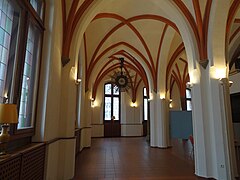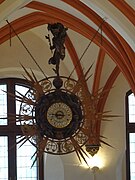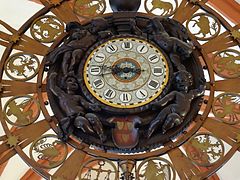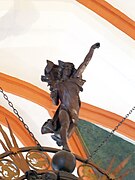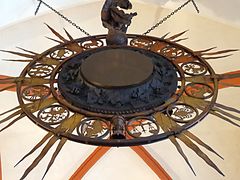Patriotic Society of 1765

The Patriotic Society of 1765 was founded on April 11, 1765 in Hamburg as the Hamburg Society for the Advancement of the Arts and Useful Trades in the Enlightenment . It is a non-profit association supported by the citizens of Hamburg and, according to their own statements, is the oldest civil society active organization in the German-speaking area.
history
For the first time in Germany, the founding members followed a movement that began in 1731 with the Dublin Society for improving Husbandry, Manufactures and other Useful Arts , now the Royal Dublin Society , and in 1753 in London with the Royal Society for the encouragement of Arts, Manufactures and Commerce , Royal Society of Arts or RSA for short , the direct role model for the founding members, and the Société d'Encouragement de l'Industrie Nationale in Paris.

Since the company was regarded as a model of an enlightened, non-profit partnership , it was given the honorable surname Patriotic Society shortly after it was founded , with " patriotism " primarily referring to the unselfish promotion of the community. In an unusual continuity that only has parallels in a few other city-states such as Basel ( Gesellschaft für das Gute und Gemeinnützige Basel ) and Lübeck ( Society for the Promotion of Charitable Activities ), it has remained true to the educational and charitable impulses and goals. For this reason, the Patriotic Society holds onto its old name and surname to this day and thus preserves its historical legacy.
Initiatives of the Patriotic Society and its members in 1765 led to the introduction of the lightning rod and the cultivation of potatoes in Hamburg, the establishment of the first savings bank in Europe in 1778 (in connection with the establishment of the General Supply Institution, dissolved in 1810), the Association for Hamburg History in the year 1839 and the Hamburg public library as well as the Hamburg poor system and the proof of work for port workers (a forerunner of the employment office ). From the drawing schools founded by the Patriotic Society, the vocational school system and the Hamburg University of Applied Sciences developed (today Hamburg University of Applied Sciences ). The Museum of Arts and Crafts in Hamburg and the Museum of Hamburg History were also founded with the support of the Patriotic Society . In 1767 she founded a school for arts and crafts, the forerunner of today's Hamburg University of Fine Arts .
In coordination with the Patriotic Society, high-ranking Hamburg citizens founded the Association for Art and Science on October 16, 1868 , which was located in the building of the Patriotic Society and already had 500 members in the year it was founded. His clubhouse was today's restaurant. The chief judge Hermann Baumeister became chairman . Numerous important lectures on the development of the city of Hamburg took place in the context of association meetings. B. Martin Haller's lecture “Vom Hamburger Rathhausbau” on November 8th, 1897. After the Überseeclub was founded in 1922 and located in the building of the Patriotic Society, the “Association for Art and Science” was dissolved. A round frieze around an aneroid barometer carved for the association by the member of the Patriotic Society and sculptor Aloys Denoth in 1888 came to the Hamburg City Hall and is located there in the southern window reveal of the Phoenix Hall. Aloys Denoth had also created the large clock in the club room, which is now the restaurant.
The Patriotic Society acts according to its motto “Useful for Hamburg. Active for the people ”. This patriotic self-image has a long tradition: Since it was founded in 1765, the Patriotic Society has shown civic engagement. It gives impetus for social improvement and puts ideas into practice. Regardless of party political interests and ideological positions, the Patriotic Society offers a forum for the free exchange of opinions. The program of events and the work of the working groups and project groups cover a wide range of topics.
The focus is on monument protection and urban development , general and vocational training, inclusion and intercultural dialogue.
The Patriotic Society is the sponsor of SeitenWechsel, a program for the personal development of managers and young leaders, and the Diesterweg Scholarship Hamburg.
This first family education grant in Germany supports gifted children from socially disadvantaged districts in the transition to secondary school and thus contributes to more equal opportunities in the educational system and participation in society. The program was developed by the Polytechnic Society in Frankfurt am Main . Starting in 2016, with the support of the Authority for Labor, Social Affairs, Family and Integration as well as the Authority for School and Vocational Training Hamburg and a strong community of Hamburg foundations and companies, 12 children in Hamburg can be accepted into the Diesterweg Scholarship each year.
The Patriotic Society supports the Hamburg street magazine Hinz & Kunzt as a partner and promotes young talents in the field of planning and architecture with the Germany-wide “Bülau competition”.
Recently, for example, the Patriotic Society of 1765 created a non-governmental initiative for the installation of memorial plaques and with e AKTIVOLI an online volunteer exchange for Hamburg. In June 2015, the Patriotic Society had stumbling blocks laid for its Jewish members who had been excluded under National Socialism .
House of the Patriotic Society

The house of the Patriotic Society on Trostbrücke / Börsenbrücke stands on the place where the old Hamburg town hall had been located since the 13th century until it was blown up during the Great Fire in 1842 . After a competition in 1844, the building was built from 1845 to 1847 according to plans by Theodor Bülau . The building should be groundbreaking for the Hanseatic city from an architectural point of view and correspond to the goals of society for better craft training. It was therefore created using the most modern construction technology (concrete foundation, asphalt floors) and facilities (water closet) as well as, contrary to the prevailing plastered construction typical of the time, based on brick Gothic as a brick shell. From 1847 the members of the Hamburg Artists' Association from 1832 met there at their club meetings. From 1848 to 1850 it was the meeting place for the Hamburg Constituent Assembly and from 1859 to 1897 for the citizenship .
From 1923 to 1924 the building, which was originally lined with water on two sides (a northern part of the canal was filled in after 1945), was increased to the side of the Nikolaifleetes in consideration of the existing Klophaus & Schoch. In 1923 the house was entered on the list of monuments as one of the early protected positions. The Übersee-Club now also has its domicile here, but had to cease its activities during the National Socialist era. The severe damage to the house, which was partially burned out during the Second World War , meant that the library and the window tracery in the large hall were lost. During the reconstruction by Friedrich Ostermeyer and Paul Suhr, which began in 1945 and was completed in several stages by 1957 , the event halls of the house were restored in a contemporary style. The library of the Patriotic Society was not rebuilt. The expressionist increase was simplified; the tracery windows of the meeting room were renewed with a modified design. Ostermeyer and Suhr also redesigned the interiors by using colorful mosaics , shiny natural stone and gold anodized .
The sculptor Aloys Denoth created a large hanging clock for the building, which can still be admired on the ground floor in the “Zum alten Rathaus” room. In the inner field it shows an artistic clock surrounded by a wooden wreath with four carved putti, including the three shields of the painters / artists. The wooden wreath is framed by a metal wreath with sunbeams and the 12 zodiac signs and an hourglass as a reminder of transience. On top of the globe, the figure of Mercury (Hermes), the patron god of merchants, can be seen with a winged helmet, herald's staff and winged shoes.
Medals
Since 1777, on the initiative of the Patriotic Society, it has been customary to honor long-term and committed employees in Hamburg companies by awarding service medals and certificates. The income from the sale of medals for 10, 25, 40 and 50 years of service is used for the charitable purposes of the company.
Members (selection)
- Wilhelm Amsinck (1752–1831), Senator and Mayor
- Johann August Arens (1757–1806), architect
- Ferdinand Beneke (1774–1848), lawyer and politician
- Johann Joachim Bolten (1752–1835), lawyer
- Peter Breiß (1770–1846), German educator, honorary member
- Johann Georg Büsch (1728–1800), educator and publicist
- Friedrich Ludwig Christian Cropp (1718–1796), doctor, book and art collector
- Aloys Denoth (1851-1893), sculptor
- Franz Gustav Joachim Forsmann (1795–1878), architect
- Paul Dietrich Giseke (1741–1796), doctor, botanist and librarian
- Johann Hinrich Gossler (1738–1790), banker
- Johann Arnold Günther (1755–1805), senator and enlightener
- Salomon Heine (1767–1844), banker and public benefactor, honorary member
- Johann Michael Hudtwalcker (1747-1818), businessman
- Daniel Heinrich Jacobj (1820–1886), lawyer
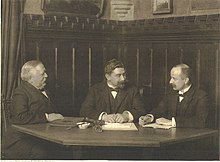
- Nicolaus Anton Johann Kirchhof (1725–1800), merchant, senator and scholar
- Anton August Heinrich Lichtenstein (1753–1816), zoologist and librarian
- Conrad Johann Matthiessen (1751–1822), merchant and banker
- Wilhelm Hildemar Mielck (1840–1896), pharmacist and Low German linguist
- Friedrich Johann Lorenz Meyer (1760–1844), lawyer and travel writer
- Johann Friedrich Albrecht August Meyer (1807-1893), lawyer
- Gottfried Jacob Jänisch (1751–1830), doctor
- Martin Johann Jenisch (1760–1827), businessman and senator
- Ulrich Moller (1733–1807), businessman and co-founder of the Patriotic Society
- Ingrid Nümann-Seidewinkel (* 1943), lawyer and politician (SPD), chairwoman of the Patriotic Society
- Carl Friedrich Petersen (1809–1892), lawyer and First Mayor of Hamburg
- Johann Albert Heinrich Reimarus (1729–1814), doctor
- Johann Theodor Reinke (1749–1825), engineer
- Peter Friedrich Röding (1767–1846), merchant and art collector
- Sebastian Vitus Schlupf (1761–1826), sculptor and teacher of decorative drawing 1792–1811
- Nicolaus Schuback (1700–1783), lawyer and mayor
- Georg Heinrich Sieveking (1751–1799), businessman
- Heinrich Christian Sieveking (1752–1809), businessman and senator
- Ernst Georg Sonnin (1713–1794), architect
- Johann Peter von Spreckelsen (1722–1795), lawyer and senator
- Ernst Gottfried Vivié (1823–1902), sculptor, chairman
- Caspar Voght (1752–1839), businessman and social reformer
- Carl Ludwig Wimmel (1786–1845), architect
- Andreas Christian Wolters (1770–1827), lawyer and senator
- Georg Friedrich Vorwerk (1793–1867), businessman
Works
- Negotiations and writings of the Hamburg Society for the Promotion of the Arts and Useful Trades , Verlag Carl Ernst Bohn, Hamburg, Vol. 1 (1790) Dig. , 2 (1791) Dig. , 3 (1792) Dig. , 4 (1793/94) Dig. , 5 (1795/96) Dig. , 6 (1797/99) Dig. , 7 (1800/05) Dig. , NF 1.1845 / 46 Dig. , NF 2.1847 Dig. , (Digital copies of the State and University Library, Hamburg).
literature
- Sigrid Schambach: Gaining the future from the present ... The history of the Patriotic Society of 1765 , Hamburg 2004 ISBN 3831901740
- Patriotic Society 1765 to 1990. An anniversary year. Hamburg, Patriotic Society of 1765, 1990.
- Gustav Kowalewski: History of the Hamburg Society for the Advancement of the Arts and Useful Trades (Patriotic Society. Donated in 1765) , self-published by the society, 1897
- Marlis Roß: The exclusion of Jewish members in 1935. The Patriotic Society under National Socialism , Patriotic Society of 1765, 2nd revised. Ed., Hamburg 2011.
- J. Smidt (Senator in Bremen) (Hrsg.): Hanseatische Magazin , 1st volume, Bremen, Friedrich Wilmans, 1799, Friedrich Johann Lorenz Meyer , VII. Hamburg Society for the Promotion of the Arts and Useful Trades. Overview of their negotiations, in the past six months from Michael 1798 to Easter 1799 , pp. - 271ff., ( Online , State and University Library Bremen).
- Jörg Schilling: The House of the Patriotic Society (Hamburg construction booklet 14), Schaff-Verlag Hamburg 2016, ISBN 978-3-944405-21-6 .
Web links
Individual evidence
- ^ Forum and House - Patriotic Society. Retrieved April 4, 2017 .
- ↑ Patriotic Society sets stumbling blocks on ndr.de
- ^ Ralf Lange : Architekturführer Hamburg , Ed. Menges 1995, p. 19
- ↑ List of monuments according to § 6 paragraph 1 Hamburg Monument Protection Act - as of December 2016 (p. 786, pdf)
- ^ Ralf Lange: Architecture in Hamburg - The great architecture guide . 1st edition. Junius Verlag, Hamburg 2008, ISBN 978-3-88506-586-9 , p. 17 .
- ^ Julius Faulwasser in: 165 Years of the Patriotic Society - a Hamburg Yearbook 1930 , page 56
- ^ Service loyalty program at patriotic-gesellschaft.de
Coordinates: 53 ° 32 ′ 54 ″ N , 9 ° 59 ′ 32 ″ E

